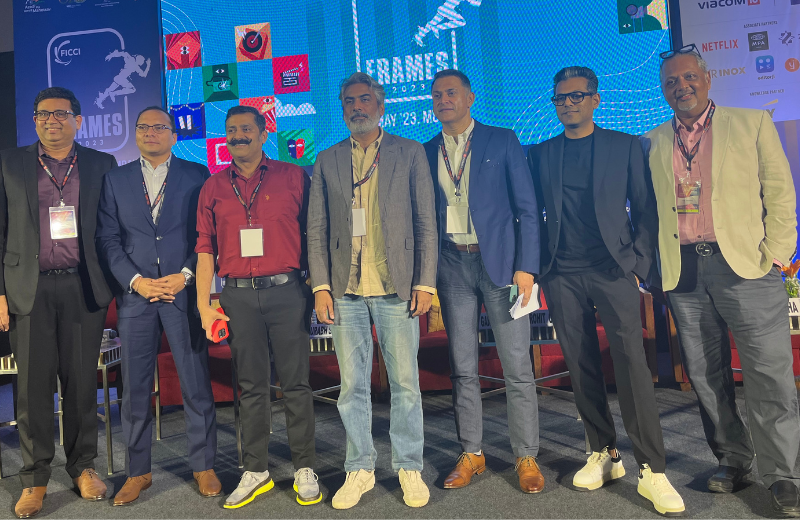Day two of FICCI Frames saw Rana Barua, group CEO, Havas Group India; Saurabh Saksena, CEO, VMLY&R India; Gangs T Gangadhar, co-founder and group CEO, Quotient Ventures; Rohit Gopakumar, COO, Optimal Media Solutions, Times Group; Dheeraj Sinha, CEO, Leo Burnett, South Asia and chairperson, BBH India; and Abe Thomas, CEO, Reliance Broadcast Network, Big FM discuss the future of advertising.
The panel was moderated by Vinit Karnik, business head - entertainment, GroupM.
Current scenario in advertising
Pointing to the fact that consumers are getting more powerful in terms of the entertainment or content they want to see, Barua said, “Consumer is becoming the king and data analytics is becoming far more critical. It's about understanding the consumer again. We need to understand that there is a change. Look at the consumer and face the challenge that’s coming.”
Agreeing with Barua, Saksena explained how there’s a penalty if a consumer’s time is not respected. “Covid was the biggest accelerant of trends. A lot has changed and a lot is constant. There's more and more pressure on the advertiser today to be able to value a consumer’s time. Their ability to invest in us and share our messages has to be respected too. From an advertising point of view - we are also responsible for converting them,” he added.
Gangadhar stated that the need for advertising is unarguable and that advertisers today have to not only entertain consumers but also inspire them. “The pressure on brands, agencies and advertisers is humongous,” he said.
Role of different mediums
Gopakumar shared that when he joined the print industry, everyone told him that he was crazy to join a medium that was dying. He recalled, “Every year, we’ve only been growing. We’ve realised that print in smaller towns is growing. Print is not dying, the reality is that we’ve just been behind in the educational aspect. We have the opportunity to pick up local-to-local advertising, which is huge because there are around 8,00,000 advertisers and we as a group don't even touch two hundred thousand. So the opportunity for retail as a market is humongous.”
He also stated that it’s not advertisers who are changing, but the audience and that the initial need economy has now become a want economy.
To explain this further, Gopakumar cited examples from brand Adidas, stating that the way a brand’s purpose-led communication can foster sales.
Highlighting the nuances of change in the industry, Sinha believed that the whole value chain was moving from advertising to solving human and business problems. “The opportunity is in moving up the value chain. What’s lost is the entitlement that advertising had. 20 years back people watched a jingle because they had no other option. Today, they can choose to interact with the content that’s interesting for them and the onus is on us. If advertising today is not optimised for attention, it’s pointless,” he explained.
Foreseen trends
Thomas noticed two clear trends. According to him, clients are now looking for solutions. “They are shifting to business outcomes. You still see a print ad with a QR code and our jockeys doing social commerce - which is the other opportunity coming in. For us, whether it is social commerce or all kinds of solutions opportunities, it is becoming a sizable revenue stream. This has thrown a huge gamut of opportunities.”
Speaking about the popular buzzword in advertising today, Barua dissed the influencer marketing segment, by claiming that he was a bit cynical when it comes to influencer marketing. He shared, “Honestly there are different kinds of influencers which make you question if you’re actually going to put your trust in them. The positive side about it is only if you’ve covered all your bases of communication and you’re then using influencer marketing for a certain category where you want to know about certain things like tourism, travel and food. But communication specialists like us will still stick to the bigger form of ideas and will probably use a bit of influencer marketing. However, I don’t see it as a very long-term thing.”
Speaking around the same topic, Saksena added that if influencers give credibility and trust to brands, only then is it valuable and something that advertisers would go after. He added, “When you see a paid media post on Instagram, cynicism does come in. All of us have experienced this and in the world of influencers, there are also many options where you don’t need to go to an influencer, but can tie up with an aggregator instead and make sure that you’re harnessing their power in bringing influencers on board.”
Ending the conversation Gopakumar stated that the world needs creativity and big ideas. “We’ll continue to rely on the human mind to do that. Even though there are used cases of Chat GPT, let’s wait and watch,” he surmised.

